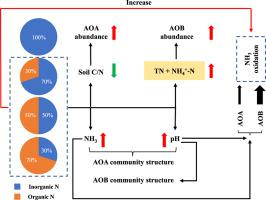European Journal of Soil Biology ( IF 4.2 ) Pub Date : 2021-01-30 , DOI: 10.1016/j.ejsobi.2021.103288 Xianglin Dai , Qiankun Guo , Dali Song , Wei Zhou , Guangrong Liu , Guoqing Liang , Ping He , Gang Sun , Fusheng Yuan , Zengbing Liu

|
Ammonia oxidation in the soil is related to nitrogen (N) availability for plants, nitrate loss, and N fertilizer use efficiency, which is important for studies on the N cycle of paddy field ecosystems. Substitution of partial mineral N fertilizer with organic amendments is commonly considered to optimize fertilization practices and reduce the application of mineral N fertilizer in the paddy fields. However, little is known about the effects of this type of fertilization on the relative contribution of ammonia-oxidizing archaea (AOA) and ammonia-oxidizing bacteria (AOB) to soil nitrification. Therefore, a 34-year field trial including five fertilization regimes (CK, without fertilizer; NPK, mineral NPK fertilizer; NPKM1, 70% inorganic N + 30% organic N + PK; NPKM2, 50% inorganic N + 50% organic N + PK; NPKM3, 30% inorganic N + 70% organic N + PK; P: phosphorus, K: potassium) was conducted. AOA and AOB abundance and community structures were determined by quantitative PCR and high-throughput sequencing analyses. Although the abundance of AOA and AOB increased with the increase in the percentage (30%–70%) of organic N substitution, the abundance ratio of AOA to AOB (133.9–84.7) decreased. Soil potential nitrification rate (PNR) increased dramatically (p < 0.05) after replacing chemical N with organic N, and with the increase in the substitution ratio of organic N in paddy soils. AOA and AOB both correlated significantly (p < 0.05) with PNR, but the contribution of AOB to PNR exceeded that of AOA. Soil carbon (C) to N ratio was the best predictor (43.0%) for AOA abundance, while total N and NH4+-N incorporating models were the best predictors (90.3%) for AOB abundance. Variations in AOA composition correlated strongly with fertilizer-induced changes in soil pH and ammonia concentration, whereas the AOB community was only markedly correlated with pH (p = 0.004). The substitution of 30%–70% of mineral N with organic N could increase the soil pH to 5.54–5.87, and that of ammonia concentration to 8.37–24.1 μM, which was the main reason that AOB contributed more to PNR than AOA. These results indicate that the organic substitution fertilizer regime had much stronger effects on the abundance and composition of AOB than AOA, and the potential contribution of AOB to ammonia oxidation in paddy soils should not be ignored after mineral N partial substitution by organic N.
中文翻译:

南方稻田长期替代有机肥对矿物肥料的影响及其对氨氧化古细菌和细菌的丰度和群落结构的影响
土壤中的氨氧化与植物的氮素利用率,硝酸盐损失和氮肥利用率有关,这对于研究稻田生态系统的氮循环非常重要。人们普遍认为用有机改良剂替代部分矿物氮肥可以优化施肥方式,并减少在稻田中施用矿物氮肥。但是,关于这种施肥对氨氧化古细菌(AOA)和氨氧化细菌(AOB)对土壤硝化的相对贡献的影响知之甚少。因此,一个34年大田试验包括五种施肥方式(CK,不施肥; NPK,矿物氮磷钾肥; NPKM 1,70%的无机N + 30%有机N + PK; NPKM 2,50%无机N + 50%有机N + PK;NPKM 3,30%的无机N + 70%的有机N + PK; P:磷,K:钾)。通过定量PCR和高通量测序分析确定了AOA和AOB的丰度和群落结构。尽管随着有机氮取代百分比(30%–70%)的增加,AOA和AOB的丰度增加,但AOA与AOB的丰度比(133.9–84.7)却降低了。 水稻土中化学氮被有机氮替代后,土壤潜在硝化速率(PNR)显着增加(p <0.05)。AOA和AOB均显着相关(p PNR <0.05),但AOB对PNR的贡献超过了AOA。土壤碳(C)/ N比是AOA丰度的最佳预测因子(43.0%),而总氮和NH 4 + -N掺入模型是AOB丰度的最佳预测因子(90.3%)。AOA组成的变化与肥料引起的土壤pH和氨浓度的变化密切相关,而AOB群落仅与pH显着相关(p = 0.004)。用有机氮替代30%–70%的矿质N可使土壤的pH值增加至5.54–5.87,将氨的pH值增加至8.37–24.1μM,这是AOB对PNR的贡献大于AOA的主要原因。这些结果表明,有机替代肥料制度对AOB的丰度和组成的影响要比AOA强烈得多,在无机氮部分替代有机N后,水稻土壤中AOB对氨氧化的潜在贡献不容忽视。


























 京公网安备 11010802027423号
京公网安备 11010802027423号